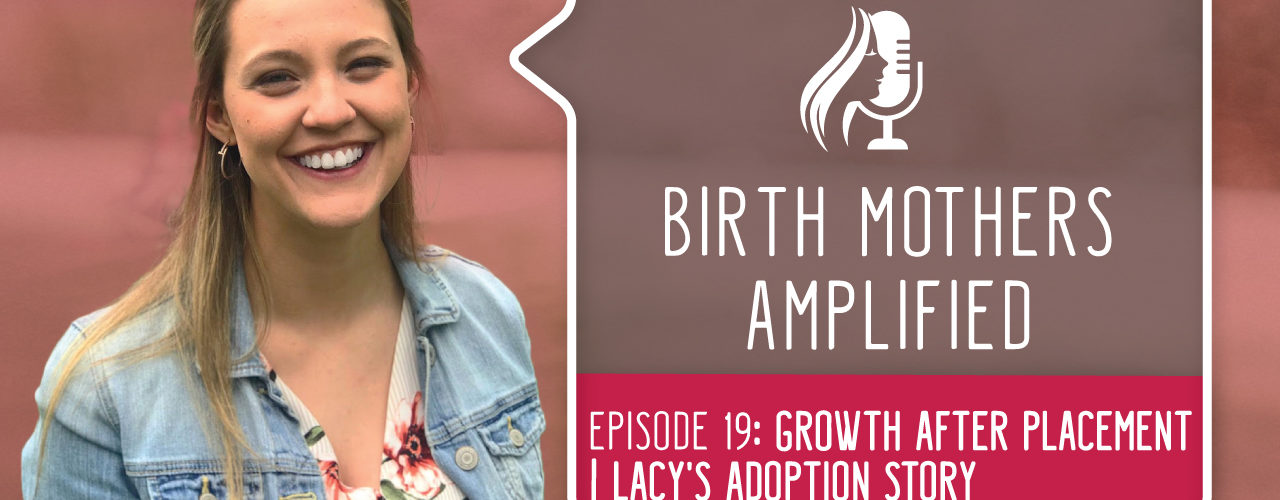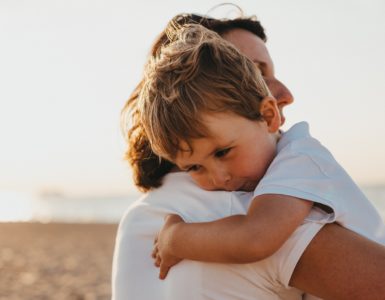Whether we like it or not, we all experience growth along our journeys. Growth can come in many forms and at many different points in our lives. In the adoption community, all members of the adoption triad experience growth before, during, and after placement. In Birth Mothers Amplified episode 19, we meet Lacy. Lacy, a birth mother of 14 years, has experienced growth in the time since she placed her daughter, specifically in setting boundaries, shifting post-placement agreements, and reuniting with her daughter’s birth father.
Lacy’s Story
Initially, Lacy was excited to be pregnant. She and her boyfriend were only 17 at the time, but they wanted to parent. Not long after they found out, Lacy left for a weekend and, when she came back, her boyfriend was acting differently than before; it was almost like he was checked out. Unsure what had happened, Lacy left and they stopped speaking to and seeing each other.
At the time, Lacy was living with her father and was still planning to parent her baby. Her father, on the other hand, had a different opinion of the situation. He told her that she couldn’t parent the baby under his roof, so he sent her to live in the dorms at the Gladney Center for Adoption during the week and allowed her to visit him on the weekends.
While there, Lacy resisted the idea of placing her baby for adoption. About seven months into the pregnancy, she started to realize that she needed to choose adoption. She started looking at adoptive family profiles and found one that looked promising, but someone else chose that couple before she could decide. She took it as a sign that she was meant to parent; she kept holding on to the hope that someone in her family would step up to help her. Her caseworker gave her more profiles, and she kept looking because she realized that no one was going to help her; she hadn’t heard from her boyfriend in several months because he was completely checked out.
In the second round of adoptive family profiles, Lacy found an adoptive couple that “checked off the boxes.” So she made contact with them, they had a few outings, and Lacy chose them to be her daughter’s parents. Now it’s been almost 15 years since she placed her daughter with them, and Lacy has experienced quite a bit of growth after placement day. If you want more details of Lacy’s story, you can watch Episode 19 of the Birth Mothers Amplified podcast on YouTube.
Setting Boundaries
Lacy experienced growth while she was setting boundaries for her daughter’s adoptive parents. Lacy said that she wanted an open adoption with an adoptive couple who lived in the same area as her so that she could be close to her daughter. She wanted the adoptive couple to have things that she didn’t have so that her daughter would have opportunities that Lacy wouldn’t be able to give her. Lacy wanted her daughter to go to a stable, two-parent home; Lacy grew up in a home with divorced and remarried parents, so that was the driving force behind that boundary. Lacy also grew up with siblings so, even if the adoptive couple didn’t have children yet, she wanted them to have plans for more children so that her daughter wouldn’t grow up as an only child. Lastly, she wanted her daughter to have educational opportunities.
When Lacy found the adoptive family, they met all of her criteria and more. There were other little things Lacy hadn’t initially thought about that helped her decide to give the family a chance. The family had a dog, which Lacy liked because she likes animals. Another little thing that helped Lacy decide was that the adoptive mother said on the phone that she was really tall. Lacy is tall, so she felt that her daughter would fit in with their family. In this way, Lacy experienced growth because she was able to accept that the adoptive family would have some characteristics that she hadn’t planned for.
Lacy experienced more growth when the day to deliver the baby came. She very clearly told the adoptive family that she did not want them to be at the hospital when she delivered her baby. “I really wanted my time to be my time,” she said. Since they couldn’t be there in person, the adoptive mom sent Lacy flowers. “The fact that they respected my boundary in that was huge,” Lacy said of the adoptive family. She went on to say that their respect brought her peace; the respect they showed made her feel like they did understand how painful it was for her to place her baby for adoption when she had originally planned on parenting her baby. Five days after giving birth, Lacy signed the relinquishment papers.
Growth can also be experienced when setting boundaries after a baby or child has been placed with his or her adoptive family. Lacy has experienced growth after placement day by being able to teach her children how to use positive adoption language. Lacy has told them her story in age-appropriate ways, and she is always proud when her 7-year-old daughter asks her questions because her daughter always uses positive adoption language when they talk. It makes Lacy proud to know that she has been a good example for her daughter in using positive adoption language.
You can also experience growth as Lacy has by setting clear boundaries with your adoptive family and by making sure that your other children use positive adoption language when they talk about your adoption story. It may at first be hard to set boundaries or to teach your children to use positive adoption language, but Lacy has found that it is worth every effort she has made. It can be worth the effort for you as well.
Shifting Post-Placement Agreements
A specific way in which Lacy experienced growth happened after she had already placed her daughter. She and the birth father got back together, so she wanted him to meet his daughter. The birth father was not there when the post-placement agreements were first made, so Lacy wanted those agreements to be shifted to include him. She told the adoptive couple that they were back together, but they were resistant to the idea at first and hesitated to say yes to him meeting his daughter. Lacy understood that they had reservations about the situation. She thinks they could have been scared that she and the birth father would want the baby back.
The adoptive couple did allow the birth father to meet his daughter, and they had a few outings with him and Lacy. Lacy began to feel that things were “getting really messy.” She doesn’t remember talking with the adoptive couple in-depth about shifting the post-placement agreements. What she does remember is sending the adoptive couple an email that said, “I think that we need to take some space.” From there, things just switched from going on outings together to a once-a-year letter exchange between Lacy and the adoptive couple. Lacy says of the switch, “I just kind of let my heart lead what I felt was right.” Lacy didn’t want to feel negative about the situation, so the shift in the post-placement agreement seemed to be the best option.
The shift wasn’t a formal agreement, so since then Lacy has felt a little stressed sending her once-a-year letter and update because she isn’t ever sure if she’ll get something back, but things seem to have worked out for her and the adoptive couple. There was one time she didn’t receive an update from them for a while, so she had to send them an email asking if they were going to send an update. The adoptive couple apologized that life had gotten in the way, sent their update, and told her never to hesitate to reach out if she doesn’t get an update from them.
Lacy hopes that the post-placement agreement can shift yet again in the future. She has three other children, and she would like her younger children to one day meet her older daughter. The adoptive couple knows that Lacy has three children now, so Lacy hopes that when her daughter is old enough or when she desires to meet Lacy’s other children that her daughter will reach out to her. She wants her daughter and her other children to eventually form a relationship on their own without the complexities of adoption getting in the way. Lacy says, “They didn’t ask to be put in this situation, and they deserve to be able to get to know each other in whatever capacity that might look like for them.”
Other people in a situation similar to Lacy’s may feel it is time to shift their post-placement agreement. The reasons may vary, but the concept is the same. For some, the best thing might be to do what Lacy did and take a break. Others might feel it is time for the break to end and for there to be more communication among the members of the adoption triad. Reach out to the people who are involved with your post-placement agreement and discuss with them what a shift could look like in your situation.
Birth Parents Reuniting
It is not unheard of for birth parents to reunite. The relationship does not always work out but, when it does, birth parents need to set boundaries with each other so as not to repeat the feelings of pain and loss that are associated with adoption. The birth father called Lacy late one night; he was crying, and he said that he’d been thinking about her. They arranged to meet and, when they did, the birth father cried while he told her that he was sorry and that he couldn’t believe all that had happened.
Lacy could see that his lifestyle had not changed from when she originally got pregnant. There were things in his life that she could not accept in hers. She told him, “If you want to be with me, you have to get it together. We can’t just go back to where we were.” Lacy set very clear boundaries for him so that they would not repeat all that had happened to them before. He called her again a little while later and said, “I’m ready. I’m ready to be with you; I’m ready to put this life behind me.” Lacy says that they jumped right back in.
Once she told the adoptive couple that they were back together, things started to feel messy. Lacy said, “I felt like I disappointed them by getting back together with the birth father.” The adoptive couple had expressed high hopes for her future, but Lacy didn’t want to have to choose between the birth father and her daughter. They took a break and shifted their post-placement agreement and, so far, things have worked out for all involved. Lacy likes to think that she chose herself by taking time to process her feelings and do what was best for her.
Other birth parents should not have to feel as though they are choosing between their partners and their children. The choice to reunite with a partner is their decision, but they should also make sure that it is in the best interest of the adoptee. The well-being of the adoptee should always be considered first because concern for the adoptee’s well-being is, for many people, the reason they considered adoption in the first place. Birth parents should ponder how their choice to reunite will affect others before they accidentally upset the careful balance in the adoption triad.
Growth After Placement
All members of the adoption triad can experience growth after placement. Perhaps your adoptee has expressed the desire to meet his or her birth parents. The desire may stem from a yearning to better understand his or her adoption story and the reasons for placement. Growth for adoptees can often come in the form of wanting to connect and have a relationship with their birth parents. Adoptive parents can experience growth after placement when their adoptees seek out their birth parents because they may want their adoptees to have a relationship with and understand their birth parents. Birth parents often experience the most growth when they desire contact with their children who have been adopted by others. In all cases and situations, growth after placement may not be the most comfortable experience for the members of the adoption triad. Growth is often uncomfortable, messy, and difficult, but if the growth seems like it will benefit the other members of the adoption triad, it can only be a good thing.
Are you ready to take the next steps on your adoption journey? Visit The Gladney Center for Adoption to learn more.



